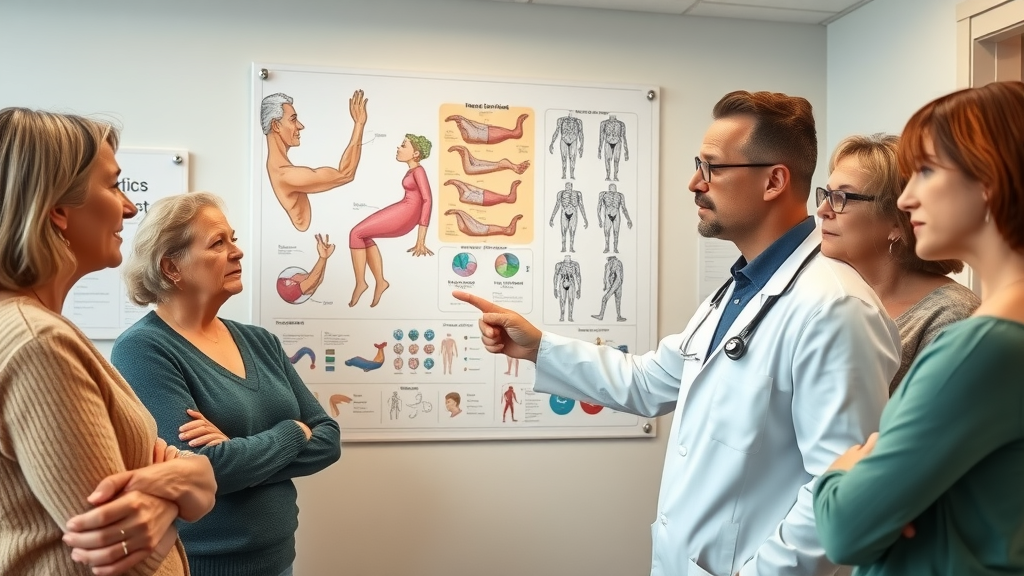Did you know that nearly 80% of adults over 40 in the United States miss at least one critical health screening—leaving them at a higher risk for serious conditions like cancer, heart disease, and more? Staying on top of essential health screenings is the single most proactive step you can take after 40. Whether you’re already focused on wellness or just beginning to prioritize preventive care, your Triangle family doctor wants you to be aware: these five tests are non-negotiable for safeguarding your future health.

Startling Statistics: Why You Can't Ignore These Health Screenings After 40
"Did you know that nearly 80% of adults over 40 miss at least one recommended health screening, putting them at higher risk for serious conditions?"
After you turn 40, your health profile changes—and so do your risks. High blood pressure, colorectal cancer, heart disease, and various cancers creep up silently, often without warning signs. According to the U.S. Preventive Services Task Force, missing just a single recommended health screening can dramatically increase your risk of delayed diagnosis, higher treatment costs, and worse outcomes. In fact, adults over 40 are statistically more likely to develop conditions that can be safely managed if caught early through regular health screenings.
Family Doctors in the Triangle stress that men and women can no longer rely on the absence of symptoms as a sign of health. Health screenings are the only way to identify “silent” health issues—like high cholesterol, cervical cancer, or cancer early—before they progress. These five tests are the cornerstone of adult preventive care. If you haven’t discussed them with your care provider yet, now is the time. Smart, timely screening is a proven way to reduce your risk factors and protect both your longevity and quality of life.
What You’ll Learn: The Essential Health Screenings You Need When Over 40
The five health tests your Family Doctors in the Triangle recommends most
Why health screenings are critical after age 40
Risks of skipping cancer screenings and blood pressure checks
How early detection can improve your health outcomes
Action steps for scheduling your next health screening

Understanding Health Screenings: What Are They and Why Are They Critical Over 40?
Definition of Health Screenings
Health screenings are medical tests designed to detect diseases or conditions before symptoms appear. For adults over 40, these screenings are a crucial form of preventive medicine—offering a powerful opportunity to identify diseases like breast cancer, skin cancer, lung cancer, or diabetes in their earliest, most treatable stages. Your primary care provider and organizations like the American Cancer Society and the U.S. Preventive Services Task Force update their recommendations regularly to make sure you get the most up-to-date guidance tailored to your age group, gender, family history, and individual risk factors.
Regular health screenings should feel routine, not intimidating. Done at your Triangle family doctor’s office, most tests are quick, simple, and covered by insurance plans. Screenings may include physical exams, bloodwork to look for high cholesterol or blood sugar, imaging studies (like mammograms or lung CT scans), and targeted checks for specific cancers. Skipping them may put you at higher risk for missed early warning signs and costlier interventions down the line.
How Health Screenings Help Detect Silent or Early Stage Diseases
Many deadly diseases start with no symptoms at all—making regular screenings essential. For example, high blood pressure (hypertension) and high cholesterol are dubbed “silent killers” because they cause no pain but raise your risk of stroke, heart disease, and other complications. Similarly, cancers like breast cancer, colorectal cancer, and cervical cancer may progress for years without obvious symptoms.
Early detection via health screenings doesn’t just increase your chance of survival. Catching cancer early often means less invasive treatment, lower medical costs, and a better quality of life. That’s why your care provider relies on a combination of science, family history, and personalized risk assessment to schedule your screenings with precision—not guesswork.
Test |
Purpose |
Recommended Frequency |
Key Risk Factors |
|---|---|---|---|
Blood Pressure Check |
Detects high blood pressure (hypertension) |
Annually or as advised |
Age, overweight, family history, high salt diet |
Cancer Screenings |
Early detection of cancers (breast, colorectal, lung, skin) |
Varies by test (mammogram: every 1–2 years; colonoscopy: every 10 years, etc.) |
Family history, smoking, age, sun exposure, personal history |
Cholesterol Blood Test |
Checks for high cholesterol and cardiovascular risk |
Every 4–6 years, or more often if at risk |
Family history, diet, obesity, diabetes |
Diabetes (Blood Sugar) |
Screens for diabetes or prediabetes |
Every 1–3 years, starting at 40–45 |
Obesity, family history, high blood pressure |
1. Blood Pressure Check: The First Line of Defense Against High Blood Pressure
Why Blood Pressure Screenings Matter After 40
High blood pressure is one of the most common—and overlooked—health risks for adults over 40. Known as a “silent killer,” hypertension rarely shows symptoms until it’s already caused serious damage to your arteries, heart, or brain. According to the American College of Cardiology, unchecked high blood pressure is a leading risk factor for heart disease and stroke, two of the top killers in the United States. Routine blood pressure checks at your Triangle family doctor’s office are simple, painless, and take less than five minutes, yet they provide essential insight into your vascular health.
Many men and women in their forties have blood pressure readings creeping upward without realizing it. The good news? Lowering blood pressure early prevents long-term complications—from heart attacks to kidney damage. The Preventive Services Task Force and the American Heart Association recommend yearly screenings, while those with higher risk—like people with a family history, obesity, or high cholesterol—may need checks even more often.
"High blood pressure is a silent killer that increases the risk of stroke and heart disease. Don't wait for symptoms—screen early."
How Often Should Adults Over 40 Get Their Blood Pressure Checked?
The frequency of blood pressure screenings depends on your current health and risk profile. For healthy adults over 40, an annual check suffices. However, if you have previous high readings, diabetes, high cholesterol, or additional cardiovascular risk factors, your Triangle family doctor may suggest checking blood pressure every 3–6 months. Regularly monitoring your numbers—both in the clinic and at home—helps establish a baseline and alert you to changes that require attention.
Don’t overlook home monitoring, especially if you’ve been diagnosed with prehypertension or hypertension. Care providers can help you track results accurately and adjust treatment if needed. The most important thing is consistency: Make appointments part of your calendar routine, just like dental cleanings or car maintenance.

Recognizing the Subtle Signs of Hypertension
Although high blood pressure is known for being symptomless, it can sometimes present with subtle signs— like occasional headaches, dizziness, or nosebleeds. Don't wait for symptoms to appear before your next check; in many cases, the first warning sign of hypertension is a serious event such as a heart attack or stroke. If you’re over 40 with risk factors or a family history, regular health screenings are essential.
Early identification through routine blood pressure checks allows your care provider to recommend simple steps—diet changes, exercise, or medications—as needed. Empowering yourself now can prevent expensive and dangerous complications later. Listen to your doctor, track your progress, and stay committed to regular appointments.
2. Cancer Screenings: Detecting The Big C Early
Types of Cancer Screening Recommended After 40
Breast cancer screening
Colorectal cancer screening
Skin cancer screening
Lung cancer screening

Why Cancer Screenings are Essential Once You Cross 40
The odds of developing certain types of cancer increase significantly after age 40. Cancer Society statistics show that breast cancer, colorectal cancer, and lung cancer are among the leading causes of cancer deaths for adults in this age group. Regular cancer screenings, tailored to your gender and family history, allow your Triangle family doctor to find cancer early—before it spreads, and while it’s still highly curable.
Skipping screenings puts you in a “higher risk” category. For instance, missing a mammogram or colonoscopy can allow a small tumor or polyp to grow undetected, making treatment harder and less successful. According to the Preventive Services Task Force, cancer screening can decrease mortality rates dramatically for breast cancer, colon cancer, and cervical cancer when performed on time. Don’t wait for symptoms; let science and your care provider’s advice guide your schedule.
Cancer Screening Guidelines: What Family Doctors in the Triangle Advise
The U.S. Preventive Services Task Force and the American Cancer Society offer specific guidelines for each cancer type:
Breast cancer screening (mammograms): every 1–2 years starting at age 40–50, earlier for high-risk women
Colorectal cancer screening: starting at age 45 (or 40 for higher-risk individuals), using colonoscopy or stool tests
Skin cancer checks: annually or as advised, especially if you have a family or personal history of skin cancer or excessive sun exposure
Lung cancer screening: yearly low-dose CT scans for adults 50–80 years old with a history of heavy smoking
Family Doctors in the Triangle. Individualize your screening timeline based on age, history, and lifestyle. Ask your provider for a personalized screening calendar, and revisit it every year to ensure no important test is missed.
Case Study: Success Stories from Early Detection
Consider the story of Mary, a 48-year-old local who went for a routine mammogram despite having no family history or symptoms. Her imaging found a tiny, early-stage cancer—so small that it would have gone undetected for years. After minimally invasive treatment, Mary returned to her life cancer-free. Similar stories are echoed by men and women who participated in regular colonoscopies and caught colon cancer early, saving time, money, and even their lives.
The lesson: Early detection saves lives, lowers stress, and allows options. Be your own advocate. Work with your Triangle family doctor and don’t skip cancer screenings—the outcomes speak for themselves.
3. Colorectal Cancer Screening: The Test That Could Save Your Life
Why Colorectal Cancer Screening Is Crucial After 40
Colorectal cancer is one of the most preventable—yet still common—forms of cancer affecting men and women over 40. According to the American Cancer Society, colorectal cancer often develops silently, showing no symptoms until the disease is advanced. Early screening can catch precancerous polyps and remove them before they become cancer, drastically reducing your risk of life-threatening complications.
Family Doctors in the Triangle warn that factors such as family history, history of inflammatory bowel disease, high-fat diets, and certain genetic syndromes place you at higher risk. Staying on schedule with colorectal cancer screening is your best defense—beginning at age 45 for most adults, or earlier if you’re considered high-risk.
Colorectal Cancer Screening Methods: What Are Your Options?
Several screening tools can help detect colorectal cancer early. Your primary care provider will recommend a method based on your health history, preferences, and risk factors. The most common options include:
Fecal Immunochemical Test (FIT): A non-invasive stool test performed yearly at home
Colonoscopy: A thorough examination of the colon, usually every 10 years
Flexible Sigmoidoscopy: Focuses on the lower part of the colon, recommended every 5 years
Each test has pros and cons. FIT is easy and convenient but less thorough than a colonoscopy. Colonoscopy is the gold standard for finding and removing polyps, but it requires bowel prep and sedation.
Comparison of Colorectal Cancer Screening Methods |
|||
Screening Method |
Pros |
Cons |
Recommended Frequency |
|---|---|---|---|
Fecal Immunochemical Test (FIT) |
Non-invasive, no prep, can be done at home |
May miss some cancers/polyps, needs repeating yearly |
Annually |
Colonoscopy |
Most thorough, polyps can be removed during test |
Requires prep/sedation, more invasive |
Every 10 years |
Flexible Sigmoidoscopy |
Less invasive than a colonoscopy, quick |
Misses cancers higher in colon, requires prep |
Every 5 years |
Understanding Risk Factors and Symptoms
Major risk factors for colorectal cancer include being over 45, personal or family history of colon cancer or polyps, sedentary lifestyle, smoking, heavy alcohol use, and diets high in red or processed meats. Symptoms like blood in stool, persistent changes in bowel habits, abdominal pain, or unexplained weight loss should trigger immediate consultation.
But here’s the catch: Most early colorectal cancers have no symptoms at all. That’s why routine screening, even when you feel great, remains essential to catch cancer before it grows or spreads.
"Early colorectal cancer usually has no symptoms — that’s why screening saves lives."
4. Skin Cancer Screening: Don’t Ignore the Body’s Largest Organ
How Often Should You Get Screened For Skin Cancer After 40?
While often overlooked, skin cancer is the most common cancer in the United States. Family history, fair skin, history of sunburns, and significant sun exposure over decades all increase your risk after 40. Your Triangle family doctor or dermatologist recommends a full-body skin exam at least once a year. More frequent checks may be needed if you have high-risk factors or a history of abnormal moles.
Don’t wait for visible changes. Early skin cancer can be completely painless yet rapidly dangerous. Avoid the trap of thinking “it’s just a mole”—have suspicious spots evaluated promptly.
Warning Signs of Skin Changes Doctors Look For
Unusual moles
Persistent sores
Rapidly changing spots
Key warning signs your doctor checks for include asymmetry, irregular borders, changes in color, a diameter larger than a pencil eraser, or any evolving spot. Persistent sores, rapidly growing nodules, and dark streaks under a nail are other important clues. If you spot any of these signs, schedule a skin cancer screening immediately.

Family Doctors in the Triangle’s Top Skin Health Tips
Protecting your skin starts with the basics: wear SPF every day, even in winter; avoid indoor tanning; and self-check your skin monthly. Triangle family doctors also stress keeping regular exams on your calendar and updating your provider about any changes between visits. When in doubt, get it checked out— early detection leads to the easiest treatment and best outcomes.
Don’t forget that moisturized, healthy skin is less likely to crack or develop sores, especially as you age. Keep an eye out for spots that itch, bleed, or don’t heal, and partner with your care provider for long-lasting dermal health.
5. Lung Cancer Screening: High-Risk Groups Over 40
Who Should Get Lung Cancer Screenings and When?
Lung cancer is a leading cause of cancer deaths among adults, but it doesn’t affect everyone equally. High-risk individuals—particularly those aged 50–80 with a significant smoking history—are prime candidates for yearly lung cancer screenings with low-dose CT scans. According to the U.S. Preventive Services Task Force, even former smokers who quit within the last 15 years may still need screening.
If you never smoked but have a family history, exposure to secondhand smoke, or certain environmental/occupational hazards, your Triangle family doctor will factor these into your personalized risk assessment. Lung cancer screening is about catching cancer early— before symptoms like persistent cough, chest pain, or unexplained weight loss appear.

Understanding Lung Cancer Screening Procedures
The primary and most effective screening tool for lung cancer is the low-dose computed tomography (LDCT) scan. This imaging test takes detailed pictures of your lungs and can find cancer at its earliest stages—sometimes years before you’d notice symptoms. The scan is quick, painless, and noninvasive. Yearly LDCT is recommended for adults with a 20-pack-year smoking history who are still smoking or have quit within 15 years, especially those 50 to 80 years of age.
Your family doctor will review your eligibility for LDCT and ensure the benefits outweigh any potential risks. Since lung cancer found early is much more treatable, don’t delay if you fit the criteria. If you’re uncertain, start the conversation at your next checkup; better to err on the side of prevention than regret.
People Also Ask
What is the over-40 health check?
Comprehensive explanation of the standard over 40 health checks, including their purpose and the tests involved.
The standard “over 40 health check” is a thorough evaluation your care provider uses to screen for common age-related conditions and risk factors. It typically includes blood pressure measurement, cholesterol and blood sugar tests, BMI assessment, cancer screenings (breast, colorectal, sometimes lung or cervical), and a review of personal and family history to assess overall health. The goal is both prevention—identifying warning signs before issues develop—and to tailor health plans for the next decade of life.
What is the risk of skipping health screenings?
Discussion of potential health risks and costly consequences of neglecting needed screenings after age 40.
Skipping recommended health screenings after 40 increases your risk for undetected diseases, late-stage cancer diagnoses, and preventable complications like heart disease or stroke. Delayed detection often leads to more invasive treatments, lower survival rates, higher medical costs, and lasting health impacts for both you and your family. Consistent screening is the most cost-effective way to stay ahead of silent killers.
What preventative screening test is recommended for a patient who is 45 years old?
Detailed overview of the recommended preventative tests for 40-year-olds, referencing current guidelines.
For adults at age 40, current guidelines from leading health authorities suggest you begin colorectal cancer screening (via FIT, sigmoidoscopy, or colonoscopy), continue or initiate annual blood pressure and cholesterol checks, assess diabetes risk, and if you’re a woman, continue regular mammograms and Pap smears as advised. High-risk patients may begin lung or skin cancer screenings earlier based on history.
What medical tests do I need at 40?
List and describe core tests essential for adults turning 40—how and why your triangle family doctor may recommend them.
At 40, core medical tests include annual blood pressure checks, fasting blood glucose, lipid/cholesterol panel, and cancer screenings relevant to your gender and risk (mammograms for women, colon cancer screening for those with family history, skin exams as warranted). Your Triangle family doctor may add more tests if you have personal or family risk factors—building a custom screening plan focused on prevention and early action.

Key Takeaways: Don’t Let These 5 Health Screenings Slip By
Early detection through regular screenings saves lives.
Personal risk factors may update your screening schedule.
Working with your Triangle family doctor ensures proper care.
All adults over 40 should establish consistent screening routines.
Proactive health screenings protect families and communities.

FAQs: Health Screenings for Adults Over 40
How do I prepare for my first health screening?
Preparation depends on the test—fasting may be needed for bloodwork, and detailed instructions will be provided for imaging or colonoscopies. Make a list of current medications, family history, and questions for your Triangle family doctor.Will my insurance cover these tests after 40?
Most insurers, including Medicare, cover preventive health screenings recommended by the U.S. Preventive Services Task Force, but coverage varies. Always verify with your provider before scheduling.How often should blood and cancer screenings be repeated?
Blood pressure: at least yearly; cancer screenings depend on test type (mammogram every 1–2 years, colonoscopy every 10, etc.). Your Triangle family doctor will personalize the timeline based on risk.Are home screening kits reliable for certain tests?
At-home kits (such as FIT for colon cancer or blood pressure cuffs) are reliable when used correctly, but always discuss results with your care provider.What lifestyle changes support better screening results?
Eat a balanced diet, exercise regularly, avoid tobacco and excess alcohol, protect your skin, and manage blood sugar and cholesterol levels for optimal screening outcomes.
Attention Doctors! Grow Your Local Family Practice with Us starting today.
Are you ready to bring more patients through your doors? My Wellness Train has a proven system designed to help.
Are you ready to bring more patients through your doors? My Wellness Train has a proven system designed to help Local Family Practice attract and retain more local patients—without wasting time or money on outdated marketing.
📞 Call us today at 984-238-6164 or 📧 email us at info@MyWellnessTrain.com to learn how we can help your practice thrive. attract and retain more local patients—without wasting time or money on outdated marketing.
 Add Row
Add Row  Add
Add 




Write A Comment